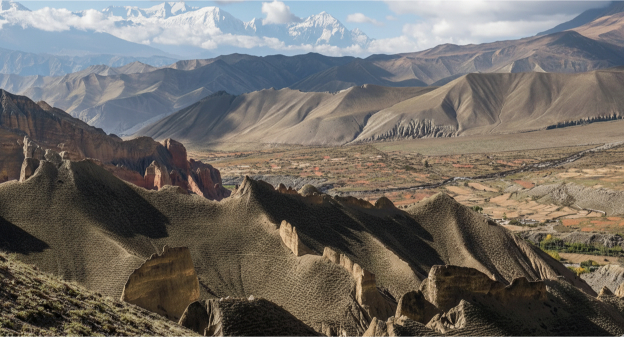
Upper Mustang / Lo Manthang (मुट्साङ)
Mountain, Natural, Historical
⭐⭐⭐⭐⭐
🇳🇵 NPR 10,000–20,000/day + permits
💵 $80–160
Description: Upper Mustang, a formerly restricted kingdom, is a land of arid canyons, ancient monasteries, and a culture that is a unique blend of Tibetan and Nepali influences. This remote, stunning region feels like stepping back in time, culminating in the historic walled city of Lo Manthang.
History & Significance
Upper Mustang was an independent kingdom until the 18th century. Its isolation and "restricted area" status, which was only opened to foreign trekkers in 1992, have helped preserve its ancient culture and traditions. The region's history is deeply connected to Tibetan Buddhism, and its ancient monasteries and stupas are of immense cultural and religious importance.
Key Features
- **Lo Manthang**, the ancient walled capital of the former Kingdom of Lo.
- Dramatic, arid landscapes with red, yellow, and brown cliffs carved by wind and water.
- Unique rock formations and ancient cave dwellings carved into the cliffs.
- Numerous Buddhist monasteries, chortens, and mani walls that reflect the region's strong spiritual heritage.
Activities & Experiences
- Trekking through the stunning, surreal landscapes, passing by unique geological formations.
- Exploring the ancient city of Lo Manthang and visiting its royal palace and monasteries.
- Observing the unique cultural traditions of the local Loba people.
- Visiting the **Tiji Festival**, a vibrant three-day ritual dance celebrated annually.
Best Time to Visit
The best time to visit is from March to November. Because Mustang is in a rain-shadow region, it is one of the few places in Nepal where trekking is excellent during the monsoon season (June-August).
Travel Tips
- Upper Mustang requires a costly **Special Trekking Permit** (currently $500 for the first 10 days).
- You must trek with a registered guide and a minimum group of two. Independent trekking is not allowed.
- The high altitude and dry conditions can be challenging. Acclimatize slowly and stay hydrated.
- The trekking route is now accessible by a road, but trekking is still the best way to experience the culture and landscapes fully.
⬅ Back to Places
